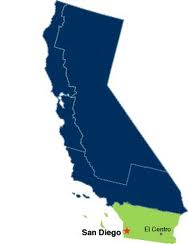District History

The Office of the United States Attorney was created by the Judiciary Act of 1789, which provided for the appointment in each judicial district of a “person learned in the law to act as attorney for the United States . . . whose duty it shall be to prosecute in each district all delinquents for crimes and offenses cognizable under the authority of the United States, and all civil actions in which the United States shall be concerned . . . .”
There are 93 United States Attorneys serving in the 94 federal judicial districts, including Guam and the Northern Mariana Islands. In California, there are four United States Attorneys' Offices: the Southern District, headquartered in San Diego with a branch office in the Imperial Valley; the Central District, headquartered in Los Angeles; the Northern District, headquartered in San Francisco; and the Eastern District, headquartered in Sacramento.
Prior to 1966, San Diego and Imperial Counties were within the jurisdiction of the Los Angeles United States Attorney, who established a one-attorney branch office here in the mid-1940s. The Office has since grown to be the sixth largest, exercising responsibility for one of the nation’s most voluminous caseloads.
San Diego is the second largest city in California and the eighth largest in the United States. Thus, the Office combats the types of criminal activity --violent, drug-related and white collar—found in any metropolitan area. The District, however, is particularly affected by its proximity to Mexico. Both San Diego County and Imperial County have large Mexican cities immediately to their south. Tijuana, directly adjacent to San Diego, is one of Mexico’s largest cities. Together, San Diego and Tijuana constitute one of the largest binational metropolitan centers in the world. Similarly, Mexicali, directly adjacent to Imperial County, is the state capital of Baja California and has a population approaching one million people.
The Southern District of California is home to the largest concentration of Navy and Marine Corps installations in the world, involving more than a half-million persons with an economic impact nearing $10 billion a year. (These include Naval Station-San Diego, Sub Base-San Diego, Naval Air Station-North Island, Naval Air Station-El Centro, Marine Corps Air Station-Miramar, U.S. Marine Corp Base-Camp Pendleton, Naval Amphibious Base-Coronado and the Space and Naval Warfare Systems Command (SPAWAR).) In addition to military bases, there are "pockets" of federal territorial jurisdiction on federal facilities throughout San Diego. For example, the District has exclusive jurisdiction over the old Customs House at the San Ysidro Port of Entry and concurrent jurisdiction over the San Diego Metropolitan Correctional Center (MCC), which houses as many as 1,000 federal prisoners. The District is also home to 18 Native American Indian tribes.
The District is bordered by Mexico on the south, with international ports of entry at San Ysidro, Otay Mesa, Tecate, Calexico (two ports, East and West) and Andrade. The Pacific Ocean forms the District’s entire western boundary. There is a major port in San Diego and a harbor in Oceanside.
This District’s unique role as the border gateway between Mexico and the rest of California contributes to the vibrant cultural, artistic and economic environment enjoyed here. Because of its location, however, the Southern District of California continues to be a major corridor for both illegal immigration and illicit drug trafficking activities. Two of the three busiest land ports of entry on the Southwest Border are located in this District. The San Ysidro Port of Entry, 15 miles south of downtown San Diego, is the busiest land border crossing in the world--inspecting more than 40 million persons and 17 million vehicles annually.

 U.S. Department
of Justice
U.S. Department
of Justice